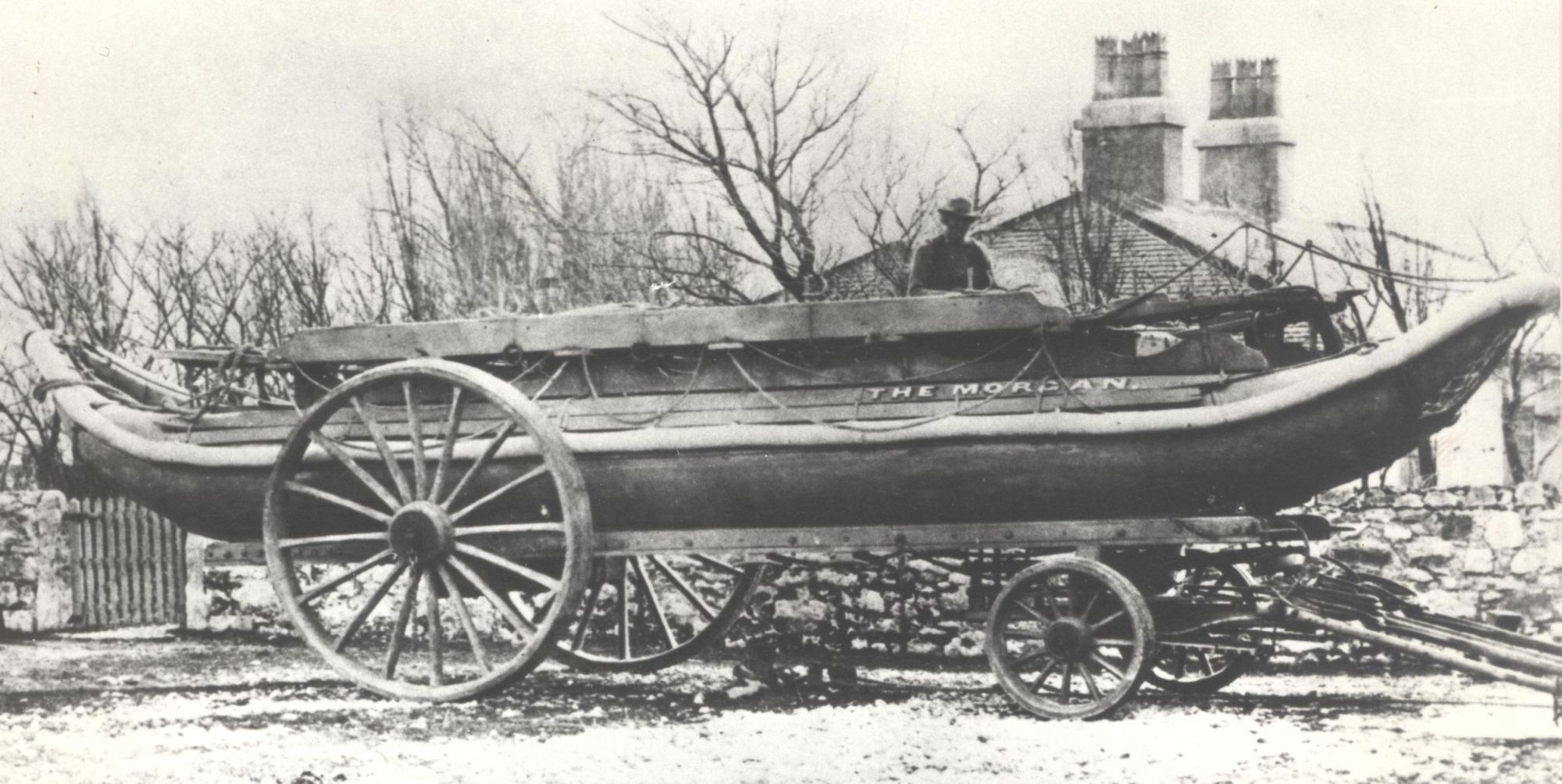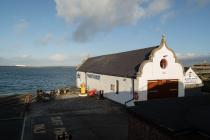Gellir lawrlwytho cynnwys at ddefnydd anfasnachol, megis defnydd personol neu ar gyfer adnoddau addysgol.
Ar gyfer defnydd masnachol cysyllwch yn uniongyrchol gyda deilydd yr hawlfraint os gwelwch yn dda.
Read more about the The Creative Archive Licence.
Disgrifiad
During the Royal Charter gale of 25-26 October 1859, the unique Rhyl lifeboat shown in the image above took part in rescue of the crew of the schooner ORIENTAL of Lancaster. The schooner was driven ashore by Foryd Telegraph Station and the lifeboat went alongside in tremendous surf to take off the six mariners.
The Caernarvon and Denbigh Herald printed the following letter of thanks on 12 November 1859:
'We, the undersigned, Robert Cuming and John Currie, the master and mate of the Oriental, of Lancaster, lately wrecked near Rhyl, do hereby certify that we were taken off the vessel, with four others by the Rhyl Tubular Lifeboat, and that in our opinion, the coxswain and crew acted with the greatest possible energy and expedition in bringing us relief, and we have never in our experience seen a better boat for the saving of life than the Rhyl Tubular Lifeboat - no lifeboat can equal her.'
In the same issue, another featured letter from A Learmouth, chief officer of the coastguard, praises the seamanship and alacrity of the coxswain Robert Bethell and the crew of the Rhyl Tubular Lifeboat.
The Shipwrecked Fishermen and Mariners Royal Benevolent Society (or Shipwrecked Mariners for short) were responsible for the establishment of the lifeboat service at Rhyl in 1850. The society had been established in 1839 by John Rye, a retired medical man, and Charles Gee Jones, a former Bristol Pilot and landlord of the Pulteney Arms in Bath. Aided by Sir Jahleel Brenton, Governer of Greenwich Hospital, the society gain a patron in Queen Victoria and managed to raise a substantial amount by public subscription. The Shipwreck Mariners ran lifeboat services in addition to having an agent in many coastal ports to providing immediate relief and aid. In 1854, it was decided that it would be wiser if one organisation, the Royal National Lifeboat Institution (RNLI), concentrated on saving lives at sea whilst the other helped survivors and their bereaved families ashore. Consequently the lifeboats operated by the society at Lytham, Rhyl, Porthmadoc, Tenby, Llanelli, Teignmouth, Hornsea and Newhaven, were passed to the RNLI.
The Shipwreck Mariners called a first public meeting to gain support for a lifeboat at Rhyl in February 1850. The lifeboat station was to be built on Lord Dinorbens land, close to the beach, between the river Clwyd and the sea. The first lifeboat was unusual because it was built in America by Joseph Francis. It proved unsuitable and it was replaced by self-righting lifeboat built by James Beeching at Great Yarmouth. When the station was handed over to the RNLI in 1854, a new lifeboat was requested. It arrived on 4 February 1856 and it was the unique craft shown above.
Designed by Henry Richardson and his son and built by Mr Lees of Manchester, the hull consisted of two iron tubes each measuring 2ft 8in diameter and connected together with iron rods curving upwards and inwards joining at the bow and stern with iron braces. These supported an open-grating deck of wood. The whole measured 32ft x 8ft 4in and had 10 rowing oars. The cost of this lifeboat was £202. A new boathouse, costing £95, was also built at Foryd Harbour.
The Rhyl tubular lifeboat was first launched on 30 December 1856 to the aid of the barque MARY ANN of Liverpool. The lifeboat went out, but the captain refused help so they returned. Later, when the barque foundered, three survivors were rescued. For its second rescue, on 4 January 1857, help was provided to the schooner TEMPERENCE of Belfast which had been was forced ashore at Abergele in heavy gales. The lifeboat rescued the four crew men.
In June 1857, Robert Bethell (mentioned with such praise in the newspaper items quoted above) was appointed coxswain at Rhyl. He was a fisherman from Hoylake and knew the dangerous mouth of Dee Estuary well. The Honorary secretary being the Reverend Hugh Morgan.
On Sunday, 7 March 1858, during a full gale a sloop was seen to be in difficulties about a mile off-shore. The crew were seen in a small boat being swept into the surf and the lifeboat men waded out to bring the shipwrecked crew to safety. Later, in the abated storm, there was an attempt to salvage the sloop. Six men approached, three managed to board it but the others had to return to shore in their waterlogged boat. The lifeboat was launched immediately to save the other three when the sloop split in two.
The Rhyl tubular lifeboat continued to be the only lifeboat at Rhyl until 1867 when a new self-righting lifeboat built by Foresst of Limehouse, London, was proposed for Abergele. With two lifeboats drawing on the same crew members, the Rhyl tubular lifeboat needed a name to differentiate it for the first time. The surname of the Hon Secretary was selected and THE MORGAN is the name we can see painted on the side.
The tubular lifeboat was extensively repaired during 1868 - once its partner lifeboat HENRY MIXON No 2 arrived on station - but it continued in service until 1893 making a total of 26 service launches and saving 32 lives.
Sources include:
Caernarvon and Denbigh Herald, 12 November 1859, Welsh Newspapers Online
Morris, J, 2002, Rhyl Lifeboats 1852-2002: 150 years of Gallantry, The Lifeboat Enthusiasts Society
Pembrokeshire Herald, 11 November 1859, Welsh Newspapers Online
Home page for the RNLI lifeboat station at Rhyl:
http://rnli.org/findmynearest/station/Pages/Rhyl-Lifeboat-Station.aspx
Use the historic Ordnance Survey mapping available on the People's Collection Wales www site to locate other lifeboat stations around the coast of Wales. How does the distribution differ from the stations in use today?
Who founded the Royal National Lifeboat Institution and when?
Who is the present Royal Patron of the Shipwrecked Fishermen and Mariners Royal Benevolent Society?






Oes gennych chi wybodaeth ychwanegol am yr eitem hon? Gadewch sylwad isod
Sylwadau (0)
Rhaid mewngofnodi i bostio sylw